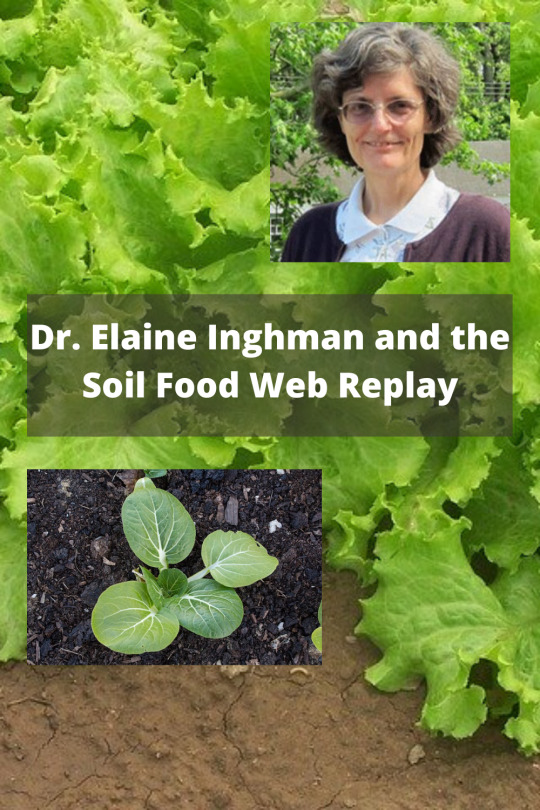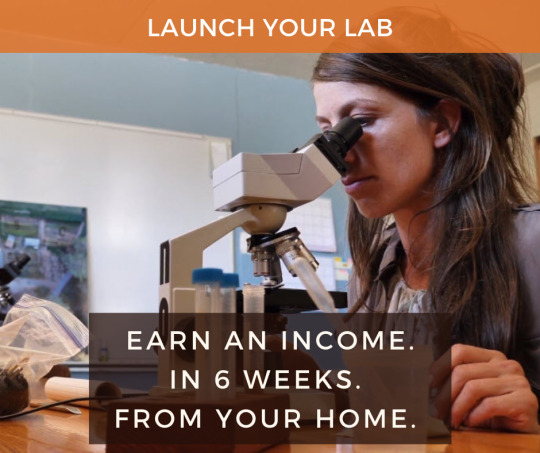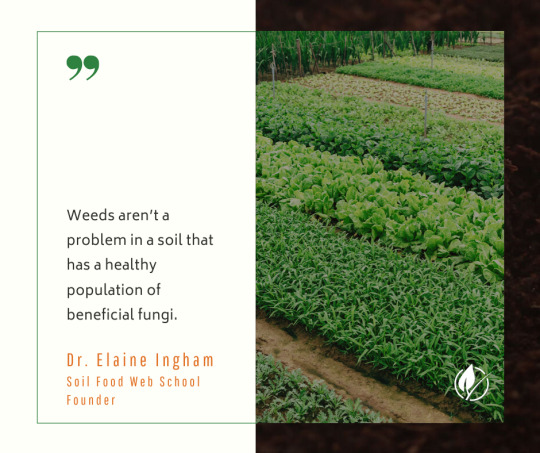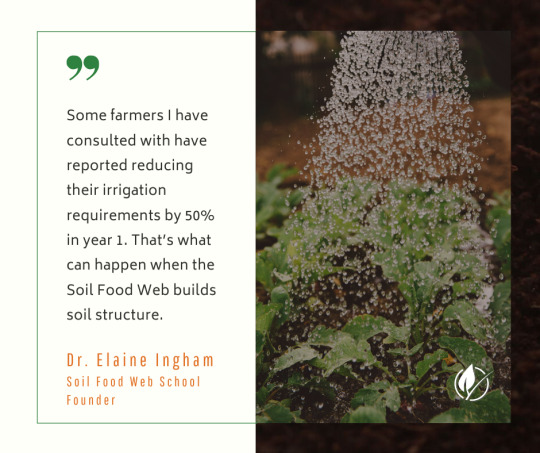#soil food web elaine ingham
Text
0 notes
Text
Soil and Food Production
How do food production and sustainable agriculture systems function?
The world, and specifically the United States, is facing high demands in food production due to increases in consumption which contribute to a rapid depletion of natural resources. As the population grows, so does the need to provide more food, resulting in fast industrial food production systems and rising stress on the agricultural business sector. Ecologists and activists, observing the unfolding of a crisis, call upon implementing more sustainable agriculture and food manufacturing methods. A grasp of the importance of soil in agriculture, the functioning of the food industry production strategies, and a look over the proposed solutions is key to understanding the contents of these systems.
The film “Symphony of Soil” portrays the importance of soil preservation and its functions in agriculture. Soil is the “crust that creates life”; it provides the plants with organic matter through the roots. It is divided into solid and empty spaces dedicated to air, water vapor, and sometimes liquid-filled pores in which living organisms thrive and keep nutrients flowing by regulating the functions of the soil and the ecosystems. Plants rely on organisms such as fungi and bacteria for organic matter that they are unable to provide for themselves. For instance, mycorrhizae, which form the basis of a symbiotic relationship between the root and fungi, provide the plant with nitrogen. A liaison between the root and bacteria is established where bacteria take nitrogen and distribute it to plants which allows it to grow. The title “Symphony of Soil” perfectly depicts the reality of soil functioning since it is composed of an entity, a food web that operates under cycles and organism interactions. Although nitrogen is essential to plant growth, its increase in natural ecosystems through pesticides does more harm than good. This green revolution deteriorates the soil and reduces its arability, limiting its livelihood and therefore yield production in the long term; the issue of chemical versus natural organic cycles in agriculture is consequently brought to light. Therefore, many attempts at revitalizing sustainable agriculture are evoked. According to Dr. Elaine Ingham, the soil varies by climate and is different in each area, creating a variety of plants proper to each ecosystem. A suggested solution is looking back at the soil functions in each ecosystem to improve farming of non-seasonal or native plants and thus learning and replicating natural processes (biomimicry). The Law of Return, as stated in the documentary, is vital to the enhancing and retaining of the soil’s capacity of renewal and resistance. Giving organic matter back to nature through composting provides higher productivity and creates an engaging community that turns scraps into plant fuel.
Biofuel, the use of organic matter to create energy, is often produced by corn,
therefore, increasing its demand and cultivation. This requires the use of pesticides producing soil erosion and leakages into rivers such as the Mississippi. This significant need for corn is also due to its inclusion in cattle alimentation on farms. Livestock feed on grass, yet, the increases in meat consumption require their augmentation, which is made possible by feeding them corn, increasing their sizes and growth.
Food Inc. tackles the limits of food production while providing necessary information for understanding its processes and promoting ideologies of a powerful consumer. As is illustrated by the documentary’s title, producing food has become a mechanical industry-based process based on assembly-line-like mass production. The ultimate goal for food providers and farming companies has shifted from consumer satisfaction to optimization of profit and productivity: “more food on less land for cheaper.” The industry faces extreme limitations to the conditions of animals, workers, and regard for customer safety and health. Cases of food poisoning due to salmonella and bacteria strands such as E.coli are constantly rising, creating health problems and spreading beyond cattle and onto vegetation due to factory runoffs. This documentary is a direct critique of the major leading business companies dominating the food industry falsely promoting a narrative of safe, healthy, and nutritious foods through advertisement, false organic labeling, and marketing. There is also a criticism of the deep corruption and relationship of politics in the food production industry, a centralized power hub against farmers, workers, and consumers. One of the Californian farmers in the documentary raises a philosophical, humanitarian-centered idea of shifts in success definitions from a money-oriented to a healthy lifestyle for consumers, enabling businesses to adopt better strategies in the food manufacturing processes. An economic concern faced today is the costliness of healthy food choices compared to other forms of fast and processed foods. This phenomenon further emphasizes the importance of changes at policy levels of food accessibility and availability. The power of the consumer comes into play; the case of Walmart proves the impact of customer dictation and shifts of market demands. Once consumers are aware and exercise their right to know what arrives on their plates, they can make different choices towards their purchases and consumption of more sustainably farmed, grown, and produced foods. This strategy can be applied through the economic viewpoint of full-cost pricing, bringing to consumers’ attention the origin of the products and their harmful effects on their health or the environment.
On a final note, food production and agricultural systems are abundant in faults, yet, referring back to nature and applying laws of return and sustainability principles prove to affect positive changes in these processes. Learning from and revitalizing soil could be a critical factor in reducing the global food crisis. Similarly, educating the consumer on utilizing their power to make better choices, remembering their rights to healthy food, and encouraging ecologically friendly and sustainable alternatives are of the essence.
Is it possible to refer to nature to tackle issues of corruption in the food industry?
956 words
Bibliography
1. Kenner, Robert, Robert Kenner, Robert Kenner, Richard Pearce, Eric Schlosser, Eric Schlosser, Melissa Robledo, et al. Food, Inc., n.d.
2. Post, Washington, - Film Journal International, - New York Times, - Civil Eats, and - The Village Voice. “Home.” Symphony of the Soil, November 14, 2016. https://symphonyofthesoil.com/.
0 notes
Text
What Are Your Charges With The Soil Regeneration
Comprehensive Decision Making is a strategy managing complex systems (like farms, families, nations, associations, et cetera). This fundamental initiative structure has been attempted on considerable number residences and farms the world over for a significant long time. It works. Thorough Decision Making considers the money related, natural, and social parts of every decision. It also offers procedures for changing decisions that aren't going as orchestrated. Moreover, it is adequately direct for agriculturists in rural Africa with emphatically no guideline to use. This is #1 on my once-over on the reason for the Soil Regeneration that most farms and land directors miss the mark in light of the way that their decisions don't adequately address the social and cash related and natural parts of their situation. Thorough Decision Making is a major fundamental to whole deal supportability.
1. Permaculture Design
Permaculture is a hypothesis, a framework science, and an overall improvement (read this article to appreciate those three sections of Permaculture). The blueprint investigation of Permaculture is a noteworthy device for farmers and land executives. It is basically scene arrange, however unlike most scene blueprint it is tweaked to the necessities of agribusiness, and it moreover considers the benchmarks of environment. A Permaculture farm will tend to be more gainful for the farmer, it will tend to have better working organic frameworks and water cycles, and it will tend to be brilliant to sweeten the arrangement much further.

2. The Soil Testing
The Soil Testing procedure is not a developing methodology, it was not created by anybody. It is basically the typical technique which licenses plants to create when substance excrements are not around (ie. for as long as an enormous number of years). Elaine Ingham has been the earth specialist who has done the most to reveal the fundamental essentialness of the Soil Food Web. The Soil Food Web insinuates the microorganisms in the earth (minuscule life forms, developments, nematodes, et cetera) which remove supplements from the soil and give these supplements direct to the establishments of living plants. Elaine Igham has shown that by managing the Soil Testing on your estate accurately you can essentially improve your plant advancement in a nutshell time allotments. This as a general rule includes a one-time utilization of well-made compost or excrement tea, trailed by an alteration in organization to secure the quality of the soil living creatures in the whole deal (no-till, common, perennials, et cetera).
3. Fittingly Managed Livestock
Similarly starting late have we began to perceive how to administer trained creatures practically. The key is to duplicate the direct of wild group in nature. In nature unlimited, overpowering herbivores package together into gatherings remembering the true objective to avoid predators. This pressing behavior has a couple of responses: the animals move ceaselessly, and don't return for a long time to a comparable piece of ground.
4. No-Till Crop Production
"Working" insinuates any major physical unsettling impact underneath the surface of the soil (wrinkling, creating, roto-working, et cetera). Working is the most hurting thing that you can do to soil living creatures. It is a great deal more terrifying than applying pesticides, fungicides, or distinctive chemicals. With new systems for controlling weeds (like particularly planned movement crops, field altering, creatures, mulch, et cetera) and planting seeds (no-till seed drills) farmers have begun to move to no-till creation. Right when a land bundle is not worked the earth life structures can develop a strong soil environment. This has gigantic favorable circumstances: looser soil (decompaction), extended supplement openness and soil readiness, less soil-borne ailments, speedier water-entrance rates (ie. less soil deterioration and flooding), et cetera. A strong soil will truly increase through and through consistently.
5. Continuing Crops
Continuing items ensure that there are living roots in the soil 100% of the time. This hinders soil crumbling, diminishes compaction, supports the earth sustenance web, and pushes the soil profile lower (makes soil).
6. Polyculture
"Polyculture" implies turning into an extensive variety of sorts of plants (and animals) in one domain. Standard agriculture uses "monocultures", which infers one and just or two plants are created in a given zone and each and every different species are persistently wiped out.
KATKUT AGRO Ukraine is constantly striving for its paramount goal - to strengthen its leading position in the agriculture sector. Find Products supplies mention below:-
Wholesale suppliers of rolled oat
Wholesale suppliers of pearl millet
Wholesale suppliers of condensed milk
Wholesale suppliers of cheese
Wholesale suppliers of evaporated milk
Wholesale suppliers of sweet cream butter
Wholesale suppliers of small red bean
Wholesale suppliers of white kidney beans
Wholesale suppliers of white millet
Wholesale suppliers of instant oat flake
Wholesale suppliers of quick cooking oat
Wholesale suppliers of chicken feet
Wholesale suppliers of butter spread/
Wholesale suppliers of milk powder
Wholesale suppliers of skimmed milk powder
Wholesale suppliers of whey powder
Wholesale suppliers of corn flour
Wholesale suppliers of wheat flour
Wholesale suppliers of cattle gallstones
Wholesale suppliers of rye
Wholesale suppliers of canary seed
Wholesale suppliers of red millet
0 notes
Photo

EAT Special Guest Dr. Elaine Ingham with Soil Food Web - Watch the Replay of this amazing webinar with Dr. Elaine Inghmam - https://www.eatcommunity.com/products/eat-free-community/categories/153602/posts/8766194
0 notes
Photo

Passion and commitment for the right things transform lives and the world. It can be done at any age! I had the privilege to be David Kincaid's (Perma Dave) first Permaculture teacher. Since I met him, the transformation in this human's life has been tremendous. His passion for bringing awareness and #education to people on the possibilities permaculture design creates in the world is contagious. During our certification course this year he launched @thepermaculturerevolution, a show with an interview series featuring some of the most stellar thought leaders, experts, educators and authors in the realm of #permaculture, #sustainability, #regenerative & #ecological #farming, #soil #sciences, #natural #building, #sustainable #living, #leadership, #entrepreneurship and more. Some of the people interviewed include Dr Elain Ingham of Soil Food Web, Andrew Millison, Permaculture Professor at Oregon University, Larry Korn, translator of One-Straw Revolution, Christian Shearer of Regen Network, Sasha Rabin of Earthen Shelter and Quail Springs Permaculture and more. My self and my partner @beekeepingypsy at @desertbloomfarm had the privilege to be interviewed also. Perma Dave is making this interview series free to the world. You can REGISTER TO VIEW IT FOR FREE AT thepermaculturerevolution.com (@thepermaculturerevolution). FANTASTIC VALUE TO THE WORLD! I highly recommend the series to anyone that works or is interested to work in the realm of permaculture, as well as regenerative development and sustainability. Join the r-evolution! https://www.instagram.com/p/B0e9Y8qlRUi/?igshid=o9fpuvaxod3j
#education#permaculture#sustainability#regenerative#ecological#farming#soil#sciences#natural#building#sustainable#living#leadership#entrepreneurship
0 notes
Text
Nematodes and Water Quality
Nematodes and Water Quality
Excerpt by – Elaine R. Ingham
Nematodes may be useful indicators of soil quality because of their tremendous diversity and their participation in many functions at different levels of the soil food web. Several researchers have proposed approaches to assessing the status of soil quality by counting the number of nematodes in different families or trophic groups.* In addition to their diversity,…
View On WordPress
0 notes
Photo

Amazing Work From Home Program! LAUNCH YOUR LAB - Join the FREE Webinar with Dr. Elaine Ingham and the Soil Food Web Team Today at 11:00 AM MDT - https://www.eatcommunity.com/elaine
0 notes
Photo

This could be a life-changing opportunity for you. Find out how you can learn and earn with Dr. Elaine Ingham and the Soil Food Web Program - http://soilfoodweb.ontraport.com/t?orid=1276&opid=58
0 notes
Photo

Hey folks, Replay of the Amazing webinar with Dr. Elaine Ingham and the Soil Food Web Consultants - https://www.eatcommunity.com/products/eat-free-community/categories/153602/posts/7097412
0 notes
Photo

Amazing Webinar with Dr. Elaine Ingham & Soil Food Web Professionals - Watch the Replay!
If you'd like to launch a new career as a soil consultant, then there is no better way to do that than to learn how soil biology really works! Watch the FREE Webinar Below! - https://www.eatcommunity.com/products/eat-free-community/categories/153602/posts/7097412
0 notes
Photo

Hey folks, this is your last chance to sign up for the amazing live webinar with Elaine Ingham of Soil Food Web School. Join FREE - https://drecolonomics.lpages.co/soil-food-web/
0 notes
Photo

Live Webinar and Q&A with Dr. Elaine Ingham - Soil Food Web School - Sign up for this FREE Webinar, it's going to be AWESOME! - https://drecolonomics.lpages.co/soil-food-web/
0 notes
Text
The Food Web and Carbon Sequestration
The Food Web and Carbon Sequestration
Excerpt by – Elaine R. Ingham
Land management practices can be chosen to increase the amount of carbon sequestered as soil organic matter and reduce the amount of CO2, a greenhouse gas, released to the atmosphere.
As the soil food web decomposes organic material, it releases carbon into the atmosphere as CO2 or converts it to a variety of forms of soil organic matter. Labile or active fractions…
View On WordPress
0 notes
Text
What is Complexity?
Excerpt by – Elaine R. Ingham
Food web complexity is a factor of both the number of species and the number of different kinds of species in the soil. For example, a soil with ten species of bacterial-feeding nematodes is less complex than a soil with ten nematode species that includes bacterial-feeders, fungal-feeders, and predatory nematodes.
Complexity can be determined, in part, from a food…
View On WordPress
0 notes
Text
Typical Food Web Structures
Typical Food Web Structures
Excerpt by – Elaine R. Ingham
The “structure” of a food web is the composition and relative numbers of organisms in each group within the soil system. Each type of ecosystem has a characteristic food web structure. Some features of food web structures include:
The ratio of fungi to bacteria is characteristic to the type of system.Grasslands and agricultural soils usually have bacterial-dominated…
View On WordPress
0 notes